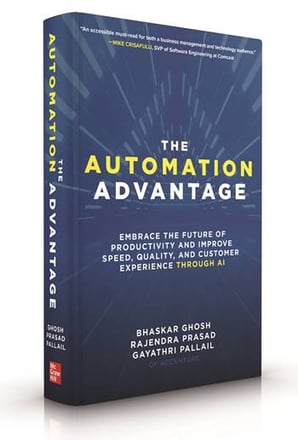A few years ago, the CIO of a large enterprise was seeking to improve automation’s impact on the business. After a series of acquisitions both big and small, headquarters functions had, for various reasons, avoided the complicated challenge of integrating business units and, as a result, operated as a decentralized group of units. With little to no communications between business units, there were wheels being reinvented by business and IT staff across the organization.
Like many IT executives, the CIO was looking for more clarity and visibility into what was happening on the ground and knew there must be countless opportunities for automating mind-numbing, error-prone processes as well. The CIO wanted to move the IT operations unit away from being a traditional cost center to become a business value driver. To that effect, the CIO initiated a chain of conversations with other members of the C-suite to bridge the gap between IT strategy and the overall business strategy of the organization.
Assessments Before Automation
Seeking to improve application stability and operational efficiency, the company undertook an automation assessment to help identify the greatest opportunities to achieve its business goals. Certain efforts were prioritized based on their synergistic potential, and the results of the assessment pointed to the potential to achieve a 45 percent reduction in incident volume and up to a 60 percent effort reduction in their regular operations. The company also was in line to save substantial costs for software tool licenses, achieve 99 percent business operations stability, and 98 percent compliance with service-level agreements with their customers.
 These were all cost-saving initiatives, and while beneficial, the CIO wanted to generate more value for the business. So he undertook an exhaustive assessment of the company’s business processes. He included business stakeholders, industry experts, and technology architects in an enterprise-wide attempt to eliminate redundant work, streamline critical activities, and boost the potential for business value creation in every process.
These were all cost-saving initiatives, and while beneficial, the CIO wanted to generate more value for the business. So he undertook an exhaustive assessment of the company’s business processes. He included business stakeholders, industry experts, and technology architects in an enterprise-wide attempt to eliminate redundant work, streamline critical activities, and boost the potential for business value creation in every process.
Once a leaner set of business processes had been established, he worked with automation architects and integration engineers to automate 40 percent of the business operations, thereby deriving tremendous value for the organization. Since then, to keep pace with the ever-changing technology landscape, the CIO has constantly reevaluated automation prospects at regular intervals in order to find additional opportunities to automate for added value.
Scaling Intelligent Automation
Intelligent automation makes benefits like those listed above a possibility for nearly any organization, but it does involve careful planning. It can be hard to determine where and how to start. Indeed, this is a major challenge for many companies: determining just what to automate first, next, and then after that. In a world of scarce budgetary resources, IT organizational capacity, and managerial attention, there must be a rational way to make these decisions.
Today, most companies are deploying technologies in pockets of their organizations, without a vision for scaling the innovation from these technologies across the enterprise. They may be chasing exciting possibilities, proving concepts, engaging people in pilots at many levels—but they are not managing or monitoring the collective impact of these initiatives, or even supporting shared learning across projects.
Too often, teams run into difficulties with scaling because they have not vetted opportunities wisely in the first place and narrowed their focus too quickly. Without overarching business priorities—including scalability—guiding these projects, potential value is left on the table. In some cases, the impact may be negligible or even negative, if efforts are expended on automating processes that were not well designed in the first place.
If CIOs and other IT leaders are serious about realizing the potential of intelligent automation, they need a way of identifying opportunities that are data driven—quantitative as well as qualitative. Leaders need to ask: What, from a business-centric perspective, would be most impactful to automate? Then: What form of automation would be feasible, given our capacity to develop and deploy solutions? And given the answers to those questions: As we map out a plan for automation that represents a valuable automation journey—with increasing capabilities and momentum toward greater automation successes in the future—what makes sense to put in place first? And what next?

First, it involves identifying processes that are valuable candidates for automation, both because they are vital to the organization’s performance and because they involve repetitive, routine information-handling tasks. Second, it calls for a clear-eyed assessment of a company’s automation maturity and therefore readiness to take on automation initiatives of different levels of sophistication. Finally, it leads to constructing a road map for undertaking initiatives in a productive sequence, so that each builds on what has been done previously. This helps the organization to steadily grow its intelligent automation capabilities and achieve maximum benefit for the business.
Choose Wisely
It’s important to note that automating work is a process in itself that can be more or less well mapped out and managed. Most businesses today understand technology’s significance in creating growth and competitive advantage, but many still struggle to transfer innovations across the enterprise and realize their potential. As a result, when a potentially game-changing innovation comes along, they cannot effectively scale it.
To avoid that problem, it is best to start with a three-part effort to eradicate, optimize, and automate. First, eliminate unnecessary work by eradicating issues and inefficiencies through root cause analysis. Then optimize the effort required to perform recurring tasks by bringing in assets and tools. And only then proceed with the intelligent automation of the activities—partially or fully, depending on priorities in the whole cycle of work. The result: automated and optimized processes that continuously bring in value and contribute to business success.
Excerpt from The Automation Advantage by Dr. Bhaskar Ghosh, Rajendra Prasad, and Gayathri Pallail ©2021. Published by McGraw Hill. All rights reserved.
Written by Bhaskar Ghosh, Rajendra Prasad & Gayathri Pallail
The authors work for Accenture. Bhaskar Ghosh, PhD, is Chief Strategy Officer, Rajendra Prasad is the Global Automation and Intelligent Assets Lead, and Gayathri Pallail is the Managing Director for Automation Strategy and Deployment. Their 2022 book is The Automation Advantage.


